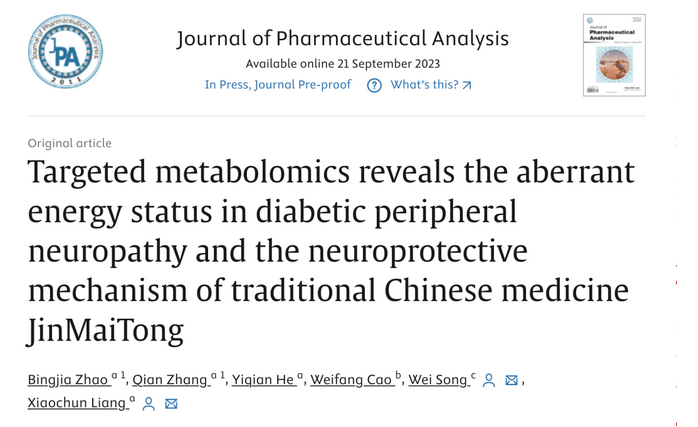Recently, the team led by Professor Liang Xiaochun from the Department of Traditional Chinese Medicine at PUMCH published online an original article in “Journal of Pharmaceutical Analysis” (a Tier 1 journal, or among the top 5%, as ranked by the Chinese Academy of Sciences). This study utilized targeted metabolomics and various molecular biology technologies to comprehensively reveal the aberrant energy metabolism in patients with diabetic peripheral neuropathy (DPN) and animal models. JinMaiTong is a TCM formula used by the Department of Traditional Chinese Medicine in PUMCH for the treatment of DPN. This study also explored the pharmacological mechanisms by which JMT protected the peripheral nerves through improving energy metabolism. This study provides new evidence for the clinical application of JinMaiTong. The study was supported by the National Natural Science Foundation of China and the National High Level Hospital Clinical Research Funding.

DPN is one of the common complications of diabetes, for which effective therapeutic drugs are currently lacking. JinMaiTong is a TCM formula developed by Professor Liang Xiaochun from the diabetes unit under the Department of Traditional Chinese Medicine at PUMCH based on TCM theory and clinical experience. It has been used for treating DPN for many years. Previous clinical studies have shown that JinMaiTong can significantly improve symptoms such as limb numbness, coldness, and pain in DPN patients. It also improves peripheral nerve function scores, increases nerve conduction velocity, and has a good safety record.
This study employed a wide range of technologies, such as ion chromatography-mass spectrometry-based targeted metabolomics, cellular bioenergetic analysis, and various molecular biological technologies. The research was conducted based on clinical samples, animal models, and cells.

▲Schematic overview of the experimental design.
Metabolomics results indicate significant impairment of the tricarboxylic acid (TCA) cycle and accumulation of glycolytic end products in DPN, and these metabolic changes exhibit distinct tissue specificity. The TCM formula JinMaiTong significantly alleviates peripheral nerve dysfunctions, pathological damages, and ultrastructural changes of the sciatic nerve in DPN animal models. It also affects multiple metabolic pathways, for example, significantly inhibiting excessive glycolysis and enhancing TCA cycle in the sciatic nerve. In-vitro studies demonstrate that JinMaiTong significantly inhibits high glucose-induced apoptosis of Schwann cells and maintains mitochondrial energy homeostasis. Further research reveals that the neuroprotective capacities of JinMaiTong should be attributed to the improved energy status with vital role of the activated AMPK/PGC-1α signaling.

▲The TCM formula JinMaiTong improves energy metabolism disorders in DPN through multiple pathways.
This study demonstrates, for the first time, the holistic energy-metabolic landscapes that are apparently disturbed in the circulatory system and peripheral nerves of patients with DPN and rodent models. JinMaiTong activates the AMPK/PGC-1α pathway to improve the multiple pathways of energy metabolism, thereby alleviating DPN symptoms and peripheral nerve damage. The “multi-component and multi-target” characteristic of TCM holds the key to its clinical efficacy, but poses a challenge to elucidating its pharmacological mechanism. This study not only reveals that JinMaiTong displays integrative regulation of energy metabolism but also provides new scientific evidence for treating DPN with the formula.

▲The aberrant energy status in diabetic peripheral neuropathy and the neuroprotective effect of JinMaiTong on DPN via modulating energy homeostasis.
Translated by Liu Haiyan
Reviewed by Sun Qing, Zhang Qian and Zhao Bingjia
